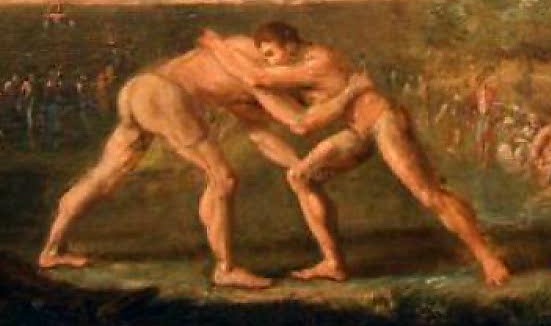
Lutte Provençales (France)
- Name of sport (game): Lutte Provençales
- Name in native language: Lutte Provençales
- Place of practice (continent, state, nation):
South of France
- History:
The region of Midi (Southern France) a stronghold of French Huguenots was also a prominent center of Lutte Provencales (Folk Wrestling Style of Provence). The region of Provence was part of Frankish Kingdoms (at first Merovingian, then Carolingian) since the VI century. The Franks were people with Germanic origins who around 800 under the rule of Charlemagne (742-814) established the Carolingian Empire in Europe. That Empire later split into two kingdoms, East Francia and West Francia, the former became known as the Kingdom of Germany and the latter was known as the Kingdom of France. Notably, the best Graeco-Roman wrestlers came from those two countries. Flemish and Dutch people were both descendants of Franks as well.
The folk wrestling style of the residents of Provence was after the old Frankish wrestling fashion. The core of all wrestling styles of Frankish origin was a combination of catch-holds and ground wrestling. Another important detail was that just like in modern professional wrestling the “lift and throw” technique played decisive role, and the use of legs and feet for throwing (hooking and tripping techniques) was insignificant in that particular style. Among the most famous practitioners of Frankish wrestling was fearless warrior Henry I, Duke of Guise (1550-1588) of Carolingian ancestry, who sometimes was called Le Balafré (Scarface).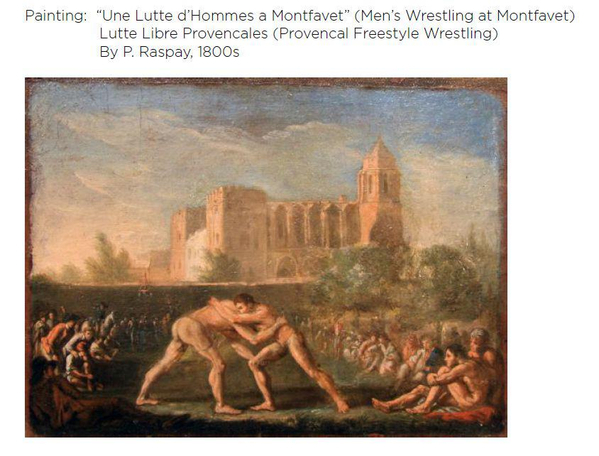
The Frankish wrestling traditions were inherited by French and German people. Simon Goulart (1543-1628) the Medieval French humanist speaks of the contemporary French and German wrestling customs in “Lichamelicke Sterckte” (Physical Strength) a chapter from his 1625 book called “Cabinet Der Historien.“ He mentioned a certain wrestling style called “Worstelen (Worstelinge), Lijf tegen Lijf”, or “La Lutte, Corps-à-Corps” which means “Wrestling, Body to Body” (Scuffle).
In this style the wrestlers started their match at a distance from each other and quickly would get into close quarters and after that proceeded as they wanted. The conditions of the match were previously negotiated by the combatants. Often to take opponent down wasn’t enough in that style, the winner had to force his adversary on his back and keep him underneath thus making him quit any resistance and verbally admit his defeat.
In France this hand-to-hand combat was known as the Burgundian wrestling (Lutte Bourguignonne). Historically, Burgundian wrestling was represented by two styles: Bras-le-Corps (equal catch-hold around the torso/waist) and Corps-à-Corps (free-for-all close wrestling combat which usually started with head-holds). The former style was a standing wrestling for a throw (back fall) and the latter was an up and down wrestling in which the objection was to overcome your opponent on the ground.
The “lift and throw” technique dominated those two styles and better developed muscles of the hip, groin and lower abdomen areas were a decisive factor. Often competitors would try to achieve a Bear Hug or a Crotch Hold on their opponent, lift him off his feet in the air, lock arms around his body and cast him down on the ground. Such Bodyslams were known as the “stones from the sky” throws (meteorite throws). Notably, use of legs and feet for throwing wasn’t favored in either of those styles, since only wrestling with hands, arms, hips and back was considered a true trial of strength and skill.
The great visualizations of those two modes of wrestling are present in the form of Romanesque sculpture at Burgundian churches, such as Church of Our Lady of the Assumption at Anzy-le-Duc (XI-XII c.) and Church of St Peter at Saint-Pierre-le-Moûtier (XII-XIII c.). Depictions of both those wrestling styles also could be found in a XIII c. Sketchbook by the architect called Villard de Honnecourt. His name and dialect indicate that he was born in Honnecourt, a small town near Cambrai in northeastern Picardy at the frontiers of Artois and Flanders.
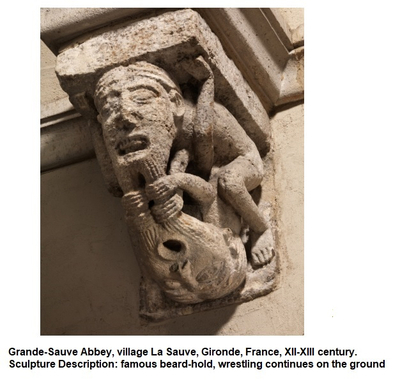
William Caxton (1422-1491) an English writer, in his translation of French prose romance "Les Quatre Filz Aymon" mentioned 2 starts in Frankish folk wrestling, “at a distance” and “close equal hug.”
Notably, the Frankish up and down catch wrestling French terminology is still in use by the practitioners of the traditional folk freestyle wrestling of the natives and residents of the Reunion Island (a French department in the Indian Ocean). That culturally unique historical wrestling style called the La Croche takes its name from the old French wrestling term a verb Se Crocher which means to catch someone, to lay advantageous hold of someone. This style is dominated by three wrestling strategies:
1) the Caler (drop, fall) a variety of take down holds and techniques used for throwing someone down from the standing position;
2) the Clef (spanner, wrench) a different limbs twisting techniques which are used in order either to cause a fall from a standing position or to roll opponent on his back when on the ground;
and
3) the Trappeur (trapper) a number of ground wrestling techniques which allow “to trap” opponent and keep him immovable underneath in a locked position thus making him quit any resistance and acknowledge his defeat which signifies a victory in this sport.
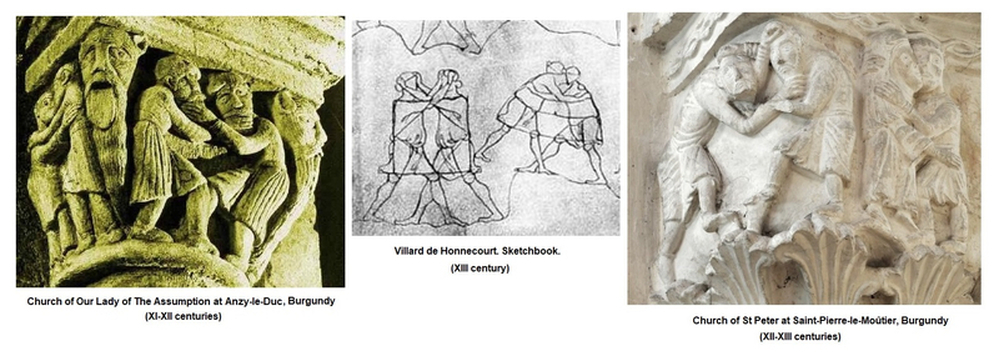
- Description:
Probably the most descriptive accounts of historical Provencal folk wrestling were provided by Henri Rolland in his short story called “The Wrestler” from the 1st volume of "Les français peints par eux-mêmes : encyclopédie morale du dix-neuvième siècle" (1841) and in the article by Jean Brunet from the 1882 book called “Revue Des Langues Romanes.”
Various wrestling games were once in strong favor among the men of Provence. The wrestling challenge matches and elimination tournaments played an essential part in celebrations at all the folk and religious holidays called the Roumavage.
Based on the traditional Provencal classification of wrestlers as per their strength there were two championship classes of local wrestlers:
1. Men’s Wrestling (Lucho dis ome) was a competition of really strong men and exceptionally strong men.
2. Half-men’s Wrestling (Lucho de miechome) was a competition of moderately strong men, young adults and youth.
There were two distinctive styles of Provencal folk wrestling:
1. Lucho de la centuro (en aut), lutte de la ceinture en haut, which was a standing catch-hold above the waist wrestling style. In this style holds of any part of the body from head to the waist including dangerous headlocks (holds around the neck) were allowed. In this style only the use of hands, arms, hips (hip lift technique) and back for throwing was legal. The objective of this wrestling style was to give the opponent a fair back fall (two shoulders touching ground simultaneously). In this wrestling style all throws were the flying falls. Often if a man was thrown on his back three times without fair back fall taking place (3 foils rule) he was declared defeated. In case of both wrestlers falling to the ground without the back fall or foil being achieved (dog fall) they had to get up quickly and renew the contest.
2. Lucho Libro, Lutte Libre, which was a freestyle wrestling. That style of wrestling was also known under the following names: lucha a touto lucha (lutter a toute lutte) or all-in wrestling, and lucha en arrapant pertout (lutter en attrapant partout) or catch-as-catch-can. In this style of wrestling holds of any part of person’s body and ground wrestling (lutto a terro) were allowed. Technically any fair method of throwing was considered legal. If both wrestlers fell down to the ground they will have to continue their struggle on the ground until one of the two is finally placed flat on his back and kept immovable (captured) in the undermost position until he gives in and admits his defeat verbally.Tripping (Croc-en-jambe) was strictly prohibited in Lutte de la ceinture en haut and technically being allowed in Lutte Libre still wasn’t favored. This was based on a local stereotype of tripping being sort of an unfair action. According to their traditions tripping was thought of as a wrestling technique that didn’t exhibit strength or skill, as they felt that true wrestling was only with hands, arms, hips and back. Interestingly, a similar stereotype dominated German wrestling customs as well. Often participants of the Men’s Wrestling championships would prefer to compete in the standing wrestling above the waist style. Their logic was based on the popular opinion that a really strong man doesn’t need holds below the waist, ground wrestling, or tripping to throw his opponent off his feet and give him a back fall or at least a foil.
But if wrestlers decided to compete on “free for all” conditions then back fall wasn’t enough to win the contest and the winner had to make his opponent quit the struggle and verbally confess his defeat.
Punching, kicking and any other unlawful or brutal act was strictly prohibited.
In the ring wrestlers appeared stripped to the waist. Traditionally, the winners of the competitions were awarded various trophies, such as silver cups, embroidered velvet underpants fringed with gold or silver, etc. Over the time professionalism was introduced in Lutte Provencales.
Sometimes the lutte libre pro wrestling matches would turn into an all-in, rough and tumble combats of wrestling and fighting combined. In those no holds barred affairs some non-wrestlng strategies like punching with the fist and kicking were a common practice.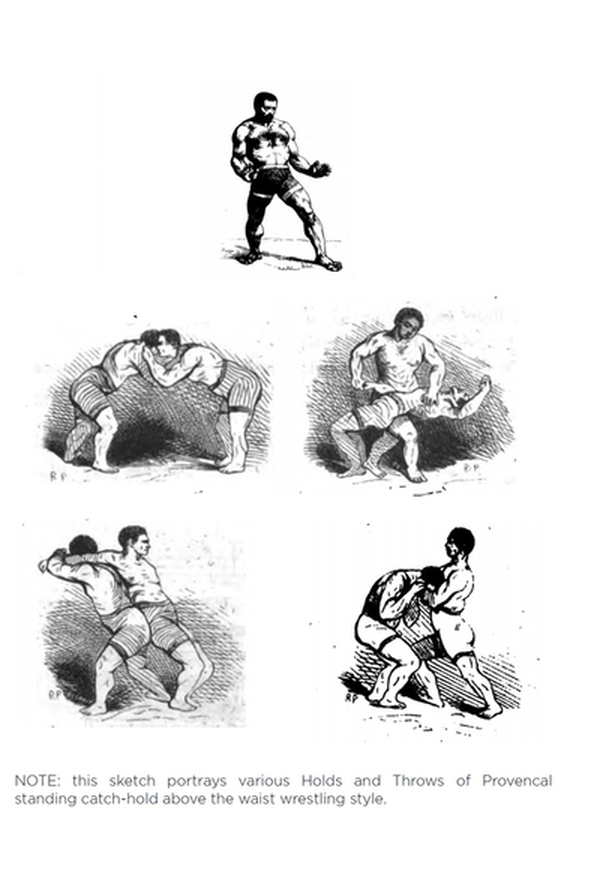
- Current status:
Currently Lutte Provencales is not practiced anymore. In France the folk wrestling styles of the residents of Provence were still around even in the 1860s until they were completely replaced with the modern French or Graeco-Roman style, which back then was also known as a “flat hand” wrestling (la lutte à main plates).
Many of the “Protestant weavers” who fled from religious persecution, migrating from Southern France to Britain in XVI-XVII centuries found their new home in East Lancashire and West Yorkshire. The waves of Flemish, German and French Protestants brought old Frankish freestyle wrestling to East Lancashire where it merged with folk English catch-hold wrestling
style and over the course of centuries it evolved there into a new unique style of wrestling the Lancashire Catch-as-catch-can. Meanwhile, on the continent, Frankish style evolved into the French wrestling, aka Graeco-Roman wrestling. Interestingly, even in the 1870s when the French style was widely exhibited in England, the most common commentary on it was that in its nature, French wrestling is very similar to Lancashire catch wrestling. - Sources of information :
Ruslan C Pashayev, The Story of Catch, 2019

